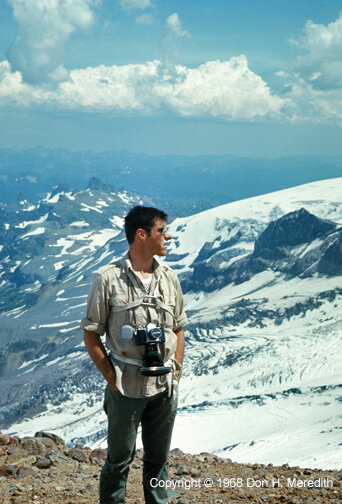
Mount Rainier
Images of Mount Rainier National Park
1966-1969
"Into a cloud sea far below, I lonely watch the red sun go,
Then turning, miracle of glad surprise, Enchanted saw the full moon rise."
— Clark E. Schurman
Chief Guide, Mount Rainier, 1939-1942
(from a plaque at Camp Schurman)
It was 1966. Vietnam was more than an exotic name on a map. The so-called "60s" were in full swing. After two years of university and under constant threat of the military draft, I was looking for a summer place to escape the increasing madness and study what I had always loved, the wilderness. When my application for employment was accepted by the US National Park Service, I jumped at the opportunity.
In the summers of 1966 through 1969, I worked as a Seasonal Fire Control Aide (1966) and Seasonal Ranger at Mount Rainier National Park in Washington State. These were ideal summers where I learned much, not only about employment and the role of the civil servant but also about national parks, mountains and mountain climbing, and the importance of wilderness and wild places to the soul. Most important, I met my future wife, Betty, and some great friends—together with whom we created some long lasting memories.
The following images were scanned from 35 mm film slides:
by Don H. Meredith
Mount Rainier—The Climbs
I had the good fortune of successfully climbing Mount Rainier (4393 m, 14 410 ft.) three times during my seasonal employment at Mount Rainier National Park, once from the Paradise (south) side and twice from the Sunrise/Emmons Glacier (northeast) side. In 1966, I took the US National Park Service Ice Climbing and Rescue course for employees which culminated in a graduation climb from the Paradise side through Camp Muir.
In 1967, I was part of a climb of Sunrise/White River park service employees, led by veteran park naturalist Art Haines. As described by one of our number, "climbing Rainier with Art Haines was like taking an extended nature walk" because of what we learned along the way. Art had a wealth of knowledge about the mountain, the park and all that lived in it. We climbed from the northeast side using the Emmons Glacier route
In 1968, I led a climb of employees, again up the Emmons Glacier route. The following images are from all three climbs.
Slide 1 — Climbing to Camp Muir from Paradise, June 1966
When I first arrived at Mount Rainier, climbing the mountain was not on my list of things to do. Yes, I had rock-scrambled up a few peaks in the Sierra Nevada but climbing on ice was not something I felt confident enough to attempt. However, looking at The Mountain every day and talking with people who had climbed it, the adventure of someday climbing it myself slowly took hold. Then not long after I started my job at Sunrise, District Ranger Jim Valder took me aside and said he would like me to take the National Park Ice Climbing and Rescue course so I would be available for rescues on the mountain. I didn't hesitate to agree.
Slide 2 — The Camp Muir shelter where we stayed during the course and the climb.
A few days later, I found myself at Paradise on the south side of the mountain with several others from around the park. Within a few hours after some orientation and distribution of gear, we started climbing to Camp Muir (3105 m, 10,188 ft.), the high camp on the south side of the mountain.
Slide 3 — Crossing a snow bridge over a crevasse. Climbers form rope teams to prevent members from falling too far. If a member falls, the others are to immediately go into a self-arrest (falling on their ice axes driven into snow and ice) to stop and anchor the climber.
At the course we learned the various ice climbing techniques, including:
roping climbers together in teams to prevent falls
the knots used in climbing
self-arrest—using an ice axe to prevent a climber from slipping down the ice
belaying techniques to assist climbers crossing difficult terrain, and
the use of ice pitons and screws to climb ice walls and belay climbers.
After we demonstrated proficiency in those skills, we learned the various rescue techniques used to extract an injured climber from a crevasse or a difficult position on rock or ice. We also learned basic first aide skills, from stopping bleeding to splinting a broken limb.
At the end of the course, we all went on a graduation climb of The Mountain in which we put some of the skills we learned to the test.

Slide 4 — Columbia Crest, the highest summit on Rainier's crater

Slide 5 — Don at Signature Rock, just below the summit, with the crater behind.

Slide 6 — On the descent to Camp Muir and on to Paradise, looking at Little Tahoma
Slide 7 — Our group taking a break at Glacier Basin after hiking up the trail from the White River Campground. After eating lunch we headed up Inter Glacier on our way to Camp Schurman at the top of Steamboat Prow.
1967 found me being the Seasonal Ranger at the backcountry cabin at Lake James. However, when I heard that Art Haines, the long-time naturalist at Sunrise, was organizing a climb of the mountain from the Sunrise side, I made sure to organize my days off to be in Sunrise at that time and to climb with Art and many of the people that worked at Sunrise and White River.

Slide 8 — Don's pack at Glacier Basin, showing some of the gear: rope, ice axe and crampons (tied to sleeping bag at bottom)

Slide 9 — Climbing up Inter Glacier on Steamboat Prow

Slide 10 — Reaching the top of Inter Glacier

Slide 11 — Appraoching Camp Schurman (2880 m, 9450 ft.) from the Emmons Glacier

Slide 12 — The Camp Schurman shelter at the top of Steamboat Prow.

Slide 13 — Roy Johnson preparing his dinner at Camp Schurman

Slide 14 — Practicing knots in the Camp Schurman Shelter, (l-r) Winn Erickson, Wally Platt, Tim Hall

Slide 15 — Inside the shelter at lights out. It was important to get a few hours sleep before getting up at 2 a.m. to begin the climb to the summit.
Slide 16 — Early morning on the Emmons Glacier, heading for the summit, Art Haines in the lead.
Climbs started early in the morning (~2 a.m.) to take advantage of the hard frozen snow on top of the glacier. Later in the day the sun softens the snow, making it more difficult to climb.
The higher up the mountain you go, the less oxygen in the air. This is the biggest challenge climbers have above 3000 metres (10,000 ft.), getting a breath. You take a couple of steps then stop to let your breath catch up, then take another couple of steps, repeat.
Slide 17 — Resting on the Emmons Glacier at dawn.
Slide 18 — At the Bergschrund (the uppermost crevasse below the headwall) before the last pitch to the summit

Slide 19 — On the summit with Mount Adams in the background

Slide 20 — Don on Summit

Slide 21 — Don on Summit

Slide 22 — Part of the crew at Signature Rock

Slide 23 — Mount St. Helens from Rainier Summit, 13 years before St. Helens erupted

Slide 24 — Yakima Park and Sunrise from the Summit
Slide 25 — John Dalle-Molle and Joe Brown eating lunch at Glacier Basin
In the summer of 1968 I was a Seasonal Ranger at Sunrise. Although there was much talk about climbing The Mountain, no one was stepping up to organize a climb. Someone suggested that I organize it, and so I did. It wasn't difficult to do because once I said it was going to happen, many people from both Sunrise and White River stepped up to participate and help out. The call of The Mountain is strong.

Slide 26 — St. Elmo Pass above Joe Brown on Inter Glacier

Slide 27 — From Inter Glacier we leave Steamboat Prow to swing out on the Emmons Glacier to come back to the top of the Prow and Camp Schurman

Slide 28 — Looking into a crevasse on Emmons Glacier from a snow bridge

Slide 29 — The plaque on the shelter at Camp Schurman
Slide 30 — The late John Dalle-Molle at Camp Schurman.
John Dalle-Molle was a good friend and colleague, a ranger's ranger, and a climber's climber. He epitomized for me (and I'm sure many others) the commitment rangers and other professionals in the US National Park Service had to the people, parks and wilderness they served. His seasons with us eventually landed him a permanent position in the service, where he served with distinction. Rest in Peace, John. May your spirit continue to soar in the mountains you love.

Slide 31 — Looking back on Camp Schurman at dawn

Slide 32 — Joe Brown and Ron Bannister resting at the Bergschrund

Slide 33 — Mount St. Helen from the summit

Slide 34 — Ron Bannister looking at Grand Park (left) and Yakima Park and Sunrise (right) from the summit
Slide 35 — John Dalle-Molle and Ron Bannister investigating a steam cave along the crater rim
When we mounted the summit crater, we smelled sulfur in the air. This was emanating from vents in the crater wall. The air coming out of the vents was warm and reminded us that we were indeed on a volcano. The hot air coming out of the vents created ice caves in the accumulated snow and ice in the crater.
Slide 36 — On the descent, time for pictures
After spending some time having lunch and exploring the crater, it was time to start the descent all the way to White River. So ended my last trip to the summit of Mount Rainier.











